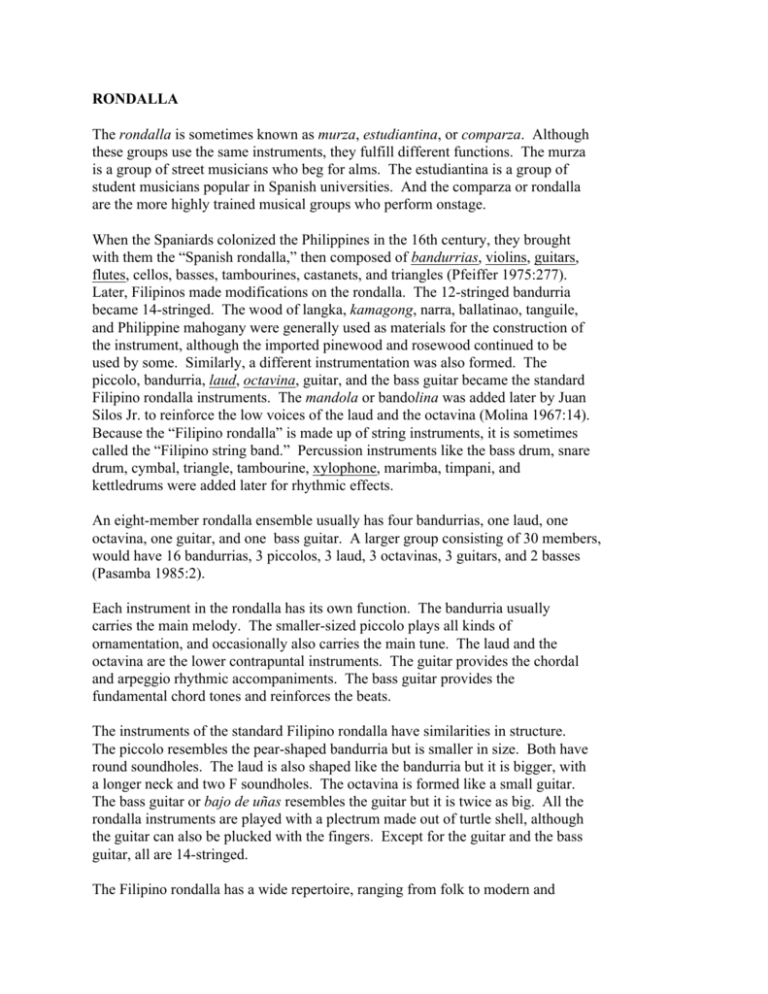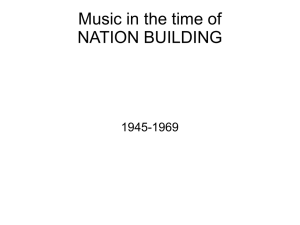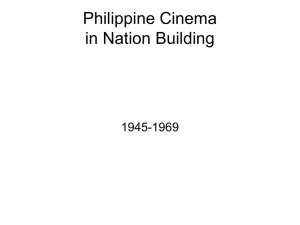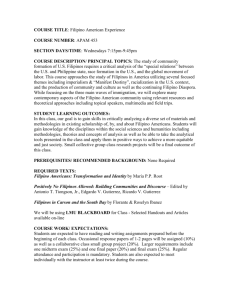Filipino Rondalla: History, Instruments, and Pioneers
advertisement

RONDALLA The rondalla is sometimes known as murza, estudiantina, or comparza. Although these groups use the same instruments, they fulfill different functions. The murza is a group of street musicians who beg for alms. The estudiantina is a group of student musicians popular in Spanish universities. And the comparza or rondalla are the more highly trained musical groups who perform onstage. When the Spaniards colonized the Philippines in the 16th century, they brought with them the “Spanish rondalla,” then composed of bandurrias, violins, guitars, flutes, cellos, basses, tambourines, castanets, and triangles (Pfeiffer 1975:277). Later, Filipinos made modifications on the rondalla. The 12-stringed bandurria became 14-stringed. The wood of langka, kamagong, narra, ballatinao, tanguile, and Philippine mahogany were generally used as materials for the construction of the instrument, although the imported pinewood and rosewood continued to be used by some. Similarly, a different instrumentation was also formed. The piccolo, bandurria, laud, octavina, guitar, and the bass guitar became the standard Filipino rondalla instruments. The mandola or bandolina was added later by Juan Silos Jr. to reinforce the low voices of the laud and the octavina (Molina 1967:14). Because the “Filipino rondalla” is made up of string instruments, it is sometimes called the “Filipino string band.” Percussion instruments like the bass drum, snare drum, cymbal, triangle, tambourine, xylophone, marimba, timpani, and kettledrums were added later for rhythmic effects. An eight-member rondalla ensemble usually has four bandurrias, one laud, one octavina, one guitar, and one bass guitar. A larger group consisting of 30 members, would have 16 bandurrias, 3 piccolos, 3 laud, 3 octavinas, 3 guitars, and 2 basses (Pasamba 1985:2). Each instrument in the rondalla has its own function. The bandurria usually carries the main melody. The smaller-sized piccolo plays all kinds of ornamentation, and occasionally also carries the main tune. The laud and the octavina are the lower contrapuntal instruments. The guitar provides the chordal and arpeggio rhythmic accompaniments. The bass guitar provides the fundamental chord tones and reinforces the beats. The instruments of the standard Filipino rondalla have similarities in structure. The piccolo resembles the pear-shaped bandurria but is smaller in size. Both have round soundholes. The laud is also shaped like the bandurria but it is bigger, with a longer neck and two F soundholes. The octavina is formed like a small guitar. The bass guitar or bajo de uñas resembles the guitar but it is twice as big. All the rondalla instruments are played with a plectrum made out of turtle shell, although the guitar can also be plucked with the fingers. Except for the guitar and the bass guitar, all are 14-stringed. The Filipino rondalla has a wide repertoire, ranging from folk to modern and contemporary tunes as well as Filipino and foreign classics. The most commonly played are folk tunes like the balitaw, harana, balse, danza, marches, and lullabies. Modern rondalla repertoire includes ragtime, love songs, and Broadway music. The classical rondalla repertoire includes the compositions of Bach, Beethoven, and Brahms. With the exception of Bayani M. de Leon and Jerry A. Dadap’s compositions, most rondalla music are transcriptions of vocal and other instrumental compositions. During the early part of the American period, many great rondalla pioneers emerged. Foremost among them was Juan Silos Jr., a Filipino composer and arranger who is known as the “father of the rondalla” (Espino 1969:2). He organized several rondalla groups including school rondallas at St.Anthony’s Institution, Centro Escolar University, Assumption College, Stella Maris College, College of the Holy Spirit, University of Santo Tomas, and the Far Eastern University. He also organized the “All-Star Filipino Rondalla” in 1949 which displayed its versatility with the performance of Tchaikovsky’s Piano Concerto No. 1 in B flat and Khatchaturian’s Saber Dance during Benny Goodman’s farewell concert in 1949. Parallelling Juan Silos Jr.’s enthusiasm and artistry in the field was Antonio J. Molina, a renowned Filipino composer of instrumental and vocal music. He formed several rondalla groups: the very versatile Comparza Joaquin, 1905-1913, which played aboard the American Luxury Liner; Rondalla Ideal, 1909-1912; Rondalla Filarmonica Juvenal, 1913, which was composed of teenagers; and Yellow Taxi Rondalla, 1940, which played with a Philharmonic Band conducted by Lucio D. San Pedro (Molina 1967:3). Another contemporary of the two great rondalla pioneers was Jose Estacion, the uncle of Juan Silos Jr. He had two famous rondalla groups: Comparza Gumamela named after the flower worn by its members on the lapel of their white coats for formal gatherings; and Rondalla Apollo, 1909, which was formed one Christmas eve at the Matute Residence, and whose members belonged to prominent families in Manila. Other rondalla pioneers at the beginning of the century were famous tenor Victorino Carrion who organized Comparza Santa Cecilia in 1908; Jose Estacion, who headed the Conservatory of Amoy, China, and organized and conducted the Philippine Rondalla in 1927; composer Hilarion F. Rubio, who acted as the consultant for the La Concordia College Rondalla in 1942; Dalmacio Samarista, who conducted Rondalla Oriental in 1914; and Macario Hernandez, who succeeded Juan Silos Jr. in directing the Centro Escolar University Rondalla (Molina 1967:3-4). The late 20th-century rondalla pioneers can be classified into two: those that are foreign-based and those that are Philippine-based. Among the most influential figures in propagating the Filipino rondalla in foreign lands are Bayani M. de Leon, Joseph Eustace Earl Peters, Michael Dadap, and Ricardo Trimillos. Bayani M. de Leon is a Filipino composer based in the United States. During the 1980s, he organized the Pasakat Rondalla and the Samahan Rondalla whose members were young Filipino-Americans in San Diego and Los Angeles, California. The two groups joined up for a recording entitled Pasakat-Samahan Rondalla. Their repertoire ranged from folk to modern as well as Filipino and foreign classics. Joseph Eustace Earl Peters, while serving as the administrative assistant of the National University of Singapore (NUS) for Musical Activities, organized the NUS Rondalla as an integral part of the elaborate Singapore Music and Music and Dance programme. Its repertoire consisted of Filipino and Asian folk and contemporary selections. Michael Dadap is a New York-based guitarist. He organized the Iskwelahang Pilipino Rondalla in Boston which had a concert tour of the Philippines in 1990. Some of the major contributions to rondalla literature by his brother, Jerry Dadap, are Choral Cycle No. 1 for Rondalla and Chorus, Ballitan No. 1 for Rondalla and Choral Symphonic Ode for Rondalla, Chorus and Orchestra (Molina 1967:12). Ricardo Trimillos is a Filipino-American ethnomusicologist, who did research on Tausug and pasyon music. He has chaired and taught at the Music Department of the University of Hawaii at Manoa, where he has organized and maintained a rondalla group composed of Filipino-American and American students. The Philippine-based rondalla pioneers promoted rondalla music through publications, performances and instruction. Angelita Cariaso-Pasamba published a series of some of her rondalla arrangements of Philippine melodies to increase the availability of rondalla scores. Enrico Pio Toledo presented a rondalla festival in 12 November 1978 at the Main Theater (now Tanghalang Nicanor S. Abelardo) of the Cultural Center of the Philippines featuring his four rondalla groups: Don BoscoTondo Rondalla, Holy Trinity Academy Rondalla, Hope Christian High School Rondalla, and Pio Valenzuela Elementary School Rondalla. Rose Puertollano was very active with the Bayanihan Philippine Dance Company Rondalla, and Edna Culig with that of the University of the Philippines (UP) Filipiniana Dance Troupe Rondalla. Among those who organized their own groups in various schools are: Carlos Valencia of the Ateneo Grade School Rondalla; Sim Elman of the Miriam High School Rondalla and the UP College of Music Extension Program Rondalla; Daniel Guerrero of the St. Scholastica’s Academy Rondalla at Marikina; Corazon Jimenez of the Philippine High School for the Arts Rondalla, 1978-1980; Bienvenido Jaravata of the Cubal-Cadael School Rondalla, 1974-1980; Edna Culig of the Dominican Daughters of the Immaculate Mother Rondalla; and Rudy de Leon of the UP College of Music Rondalla. • E. Culig References Culig, Edna. “The Development of Filipino Rondalla.” Manuscript. 1995. CCP NAMCYA Souvenir Programs 1972-1990 Defensor, Tet. “Going to Great Lengths to Form Rondalla—in Boston.” Manila Chronicle, 1 August 1990, 19. Espino Jr., Federico Licsi. “Rondalla: Recent and Reminiscent.” Mirror, 24 May 1969, 21. Molina, Antonio J. “The Rondalla.” In School Time. Edited by H.P. Vibal. Manila, February 1967. Naval, D.T. “Bandurria and Rondalla Arranging.” Research work for the Arrangers and Composers Union. Manila, 1939. Opeña, Ludivina and Ametta Suarez. “Paco Park Presents Singapore Rondalla.” Manila Bulletin, 21 April 1988. Pasamba, Angelita Cariaso. “Organization of the Rondalla.” Musical Journal of the Philippines, Vol. I, No. 6 (August 1966), 13, 44. ________ Rondalla Music. Manila: Rex Bookstore, 1985. Pfeiffer, William R. Music in the Philippines—Indigenous, Folk, Modern. Dumaguete City: Silliman Music Foundation Inc., 1975. “Rondalla Concert at the Nayong Pilipino.” Manila Bulletin, 9 April 1991, B-20. “Rondalla Fest at the Park Today,” Daily Express 15 April 1987 “Rondalla Music Keeps a Town Hall Alive.” Times Journal, 9 January 1984, 10. “Rondalla Revival.” Manila Times, 6 April 1991. Samson, Helen. Contemporary Filipino Composers. Quezon City: Manlapaz Publishing Co., 1976. Cultural Creation Under Martial Law. The martial law period showed greater experimentation in both form and content, more flexibility towards adapting various types of melodies and styles to express varied types of experiences both local and foreign. Protest singers adopted songs from China, as well as from Latin America, such as Victor Jara’s “La plegaria de un labrador” (A Worker’s Prayer) which was translated into Filipino by Jess Santiago, and “Cuando voy al trabajo” (Going to Work), translated into Filipino by Karina Constantino-David. Rock, which began as a protest medium in the West, was adopted to express revolutionary aspirations, as in the song “ Mga Babae ” (Women) written by an underground songwriter, Ka Arting, then popularly known as the “Florante ng Hukbo” (Florante of the Army). The break from the typical ideological songs, characterized by sloganeering, martial beat, and generalized messages, was precipitated by the migration of poets to the music field. In the hands of poets, the revolutionary/protest song was liberated from its formula structure, which moves predictably from statement of oppressive condition to affirmation of revolutionary optimism and the triumph of the masses. Instead, a wider range of experiences was explored, and more issues were particularized. Fresher and novel images were employed and language became more lyrical, more concrete, more subtle. Cultural creation under Martial Law had become more creative, if not more powerful, largely because of the necessity for indirection. Created right after the declaration of Martial Law, Heber Bartolome’s “Oy Utol, Buto’t Balat Ka Na’y Natutulog Ka Pa” (Hey Brother, You Are Nothing but Flesh and Bones, And Yet You Are Still Asleep), is a powerful dramatization of the conditions in the early 1970s: the cries of pain and anguish underneath the facade of calm and gaiety, the hunger, the repression, the climate of fear. This was Bartolome’s first composition and perhaps the earliest protest song created during the martial-law period, using rock instrumentalization as embellishment to essentially Western folk music (much like Bob Dylan’s fusion of rock and folk). The folk enabled the songwriter to progress from mere observation to chiding: “Ang dapat sa atin/Ay tawaging mga gago! ” (We deserve to be called stupid!) to the inevitable explosion in the end, the commitment to act. Bartolome also tackled the graver issue of the presence of US military bases in the Philippines in his song “Awit Ko” (My Song), a rock piece that expressed anguish and frustration over the Filipino’s impotence to act. In contrast to Bartolome’s Beatle-influenced instrumentation and his leanings to rock music, Jess Santiago draws from the tradition of the Western folk song, an extremely popular protest medium in America in the 1960s. Santiago’s songs, most of them in ballad style, were eloquent testimonies of the kinds of oppression people were made to endure. Poet-songwriter Joey Ayala was the first to successfully fuse rock and traditional lumad or native instrumentation in the early 1980s to produce a distinctive music that captures the rhythm and soul of Mindanao, in order to articulate the ugly realities of Mindanao life, such as vanishing rainforests, bombing of markets, hamletting of whole communities, as well as to celebrate its everyday scenes. In the countryside revolutionary songs have had a more practical and creative application. Out of the reach of the music industry and the print media, places like Samar made full use of the song as a historical document to record military atrocities and encounters. Among the Waray, traditional folk forms were revived and revitalized to become vehicles of revolutionary expression. The ismayling, a traditional song debate between a man and a woman on varied topics, like courtship, farming and other tropical issues, was used to explain party issues or to deepen the people’s understanding of national issues from the party’s point of view. The song form was also converted by the New People’s Army or NPA into a news bulletin to facilitate the transmission of news which would otherwise take three weeks to disseminate. Set to a simple folk melody, the news is learned by heart and disseminated to the people much faster. Among the peoples of Kalinga, Abra, and Bontoc, song forms like the salidummay, donglala, oynasi, balasibasem, and idi mid were recast: to narrate significant events in the struggle of the Cordillera people against the Chico Dam project and the militarization of the area; to discuss issues affecting the people in verbal-joust form; and to situate the tribal problems in the context of the Cordillera struggle as a whole. In recent years, some of these songs have been recorded and performed by the group called Salidumay. In Iloilo and Cebu, extemporaneous ballads like the composo were utilized to explain the NPA’s role in the revolution, to discuss the latest Philippine Constabulary and NPA encounter, or to expose the anomalies of the Marcos government. These songs were rich in folk humor as in the long, but never boring song “Ali Macoy” which bares the problems under the Marcos’ New Society, capping each section with the line Ali Macoy, ali Macoy/Atong dugmukon ang itlog ni Macoy (Ali Macoy, ali Macoy/We will crush the balls of Macoy). Political detention centers also contributed their share of freedom songs. “Mutya” (Muse), which is adapted from Bonifacio Abdon’s “ Kundiman,” is an offering of love and life to the beloved country, and a pledge to remain free even behind the high walls and barbed wires of Bicutan. “Pag-ibig sa Tinubuang Lupa” (Love of One’s Native Land), a poem by the revolutionary hero, Andres Bonifacio, was set to kundiman music in 1979 by Salvador Luis Jorque. It has since become one of the most popular patriotic songs of the period. The assassination of Benigno “Ninoy” Aquino Jr. on 21 August 1983 marked the turning point or the decline of the Marcos dictatorship. Various sectors and classes of Philippine society became one in pouring out of grief and indignation. As protest action escalated, songs were spontaneously created: to satirize the excesses and repressive policies of the dictatorship, as in Inang Laya’s “Binagoongang Lipunan” (Society of Salted Fish Paste), a pun on “Bagong Lipunan” or New Society and “Turismo” (Tourism); to express rage against the building of the Bataan nuclear plant, as in “Dambuhala sa Morong” (Monster in Morong); to lament the cold-blooded massacre of communities, as in Inang Laya’s “Escalante”; to decry the indignities and low pay suffered by public school teachers, as in Jane Po’s “Titser” (Teacher); to convince the public of the need to boycott the Marcos elections of 1984, as in the song “Sion, Sion” also by Po. Protest singers like Heber Bartolome, Jess Santiago, Susan Fernandez-Magno, Joey Ayala, and Paul Galang, and groups like Inang Laya and Patatag braved tear gas, water cannons, and arrest to perform in protest marches, such as the weeklong march from Central Luzon and Southern Tagalog to Manila called “Lakbayan,” in rallies and demonstrations, in pulong bayan or town meetings and open fora held in towns and cities all over the country. Folk singers like Freddie Aguilar, Coritha, and Asin, and pop singers Danny Javier and Jim Paredes of the Apo Hiking Society also joined in the mounting protest. Epilogue. The toppling of the Marcos dictatorship through the nonviolent, people-powered EDSA Revolt in February 1986 did not spell the end of protest songs. In a way, the new conditions helped to legitimize some protest singers and songwriters, as the concert halls of the Cultural Center of the Philippines and the music industry opened their doors to songs that once thrived only in the parliament of the streets. Cassette albums of Patatag, Inang Laya, Susan Fernandez-Magno, Jess Santiago, and others became available to the general public. The songs of Joey Ayala and his newly formed group, Ang Bagong Lumad, do not only bear the Universal (formerly Wea) recording company’s label but are currently being promoted in the music industry and the concert circuit. Pop stars like the Apo Hiking Society have emerged with songs that carry themes once considered too radical for the pop music industry, such as “American Junk” which speaks of colonial mentality among Filipinos. Francis Magalona’s rap “ Mga Kababayan Ko ” (My Countrymen) calls for patriotism and unity among Filipinos. Whether this recent entry of protest singers into the music industry will enrich and envigorate Pinoy music or whether the industry will sap their energies and dry up a creativity that once flourished in the mountains and the streets remains to be seen. • T.G. Maceda




